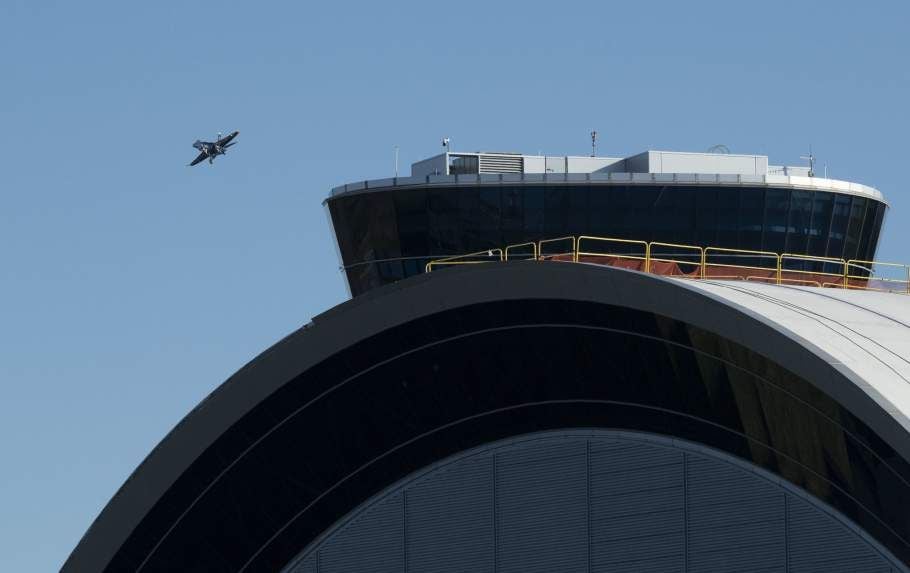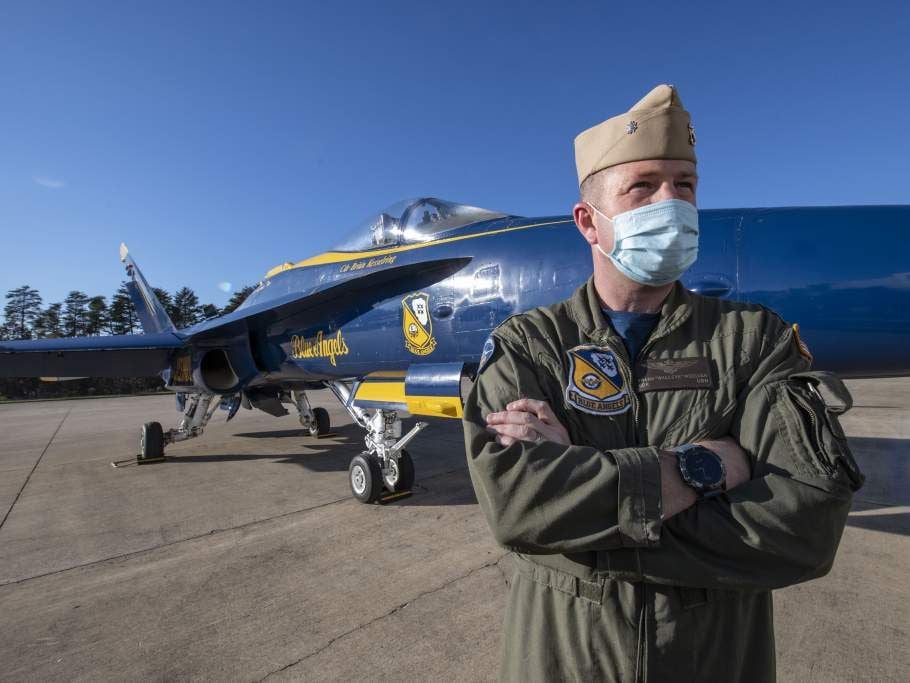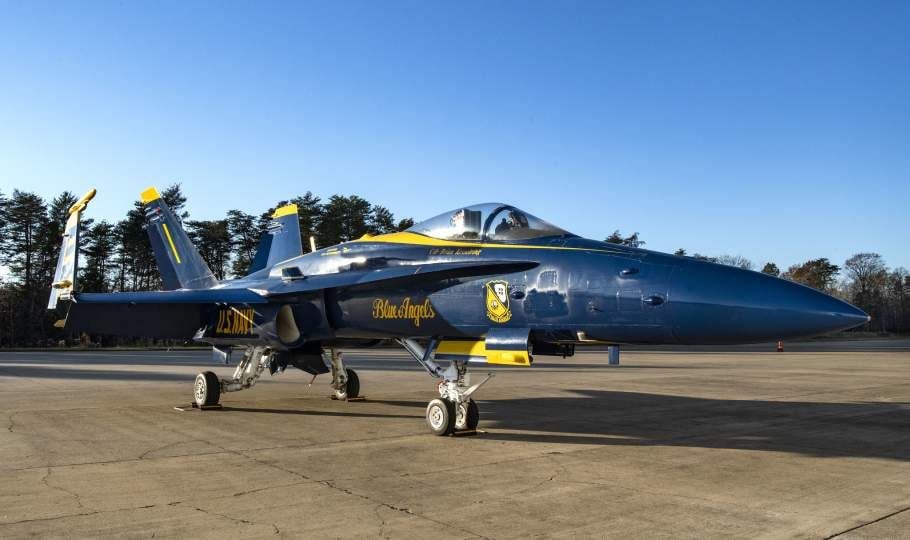A Blue Angel Makes Its Final Flight Into The National Collection
On November 18, 2020, Cmdr. Frank “Walleye” Weisser, USN, a member of the Navy’s Blue Angels flight demonstration team, flew into Dulles International Airport to deliver a McDonnell Douglas F/A-18C Hornet to the Steven F. Udvar-Hazy Center.
:focal(500x375:501x376)/https://tf-cmsv2-smithsonianmag-media.s3.amazonaws.com/blogging/featured/50618995567_e0e3485b42_k.jpg)
It is always exciting when a new aircraft is added to the National Air and Space Museum’s collection. It is even more exciting when that aircraft flies in on its own!


On November 18, 2020, Cmdr. Frank “Walleye” Weisser, USN, a member of the Navy’s Blue Angels flight demonstration team, flew into Dulles International Airport to deliver a McDonnell Douglas F/A-18C Hornet to the Steven F. Udvar-Hazy Center. The airplane arrived (and will be displayed) in Blue Angels livery, but its history goes back further than just its time with the Blue Angels.

This airplane was built in 1987, the 11th model C Hornet off the production line, and bearing Navy Bureau Number 163439. (The Bureau Number, or BuNo, is its Navy serial number.) It was soon delivered to Navy Strike Fighter Squadron (VFA) 86, the “Sidewinders.” With the squadron deployed on the USS America (CV 66), the jet flew over Lebanon in 1989, protecting the withdrawal of personnel from the American Embassy in Beirut in the face of anti-American demonstrations. In 1991, it participated in Operation DESERT STORM, pushing Saddam Hussein’s Iraqi army out of Kuwait. In 1993, the Navy transferred 163439 to VFA-83, the “Rampagers.” Assigned to the USS Enterprise (CVN 65), the airplane again flew over Iraq, helping to enforce the southern “no-fly” zone—an attempt to ensure that Hussein did not abuse minority ethnic groups in the country. By 2007, 163439 had passed through three more squadrons (VFA-115, VFA-125, and VFA-106) before delivery to the “Knighthawks” (VFA-136). Deployed to Enterprise again, the airplane once more flew over Iraq as well as Afghanistan as part of the Global War on Terror. Transferred once more in 2008 to the “Blue Diamonds” (VFA-146), 163439 continued flying in support of operations in Iraq and Afghanistan, this time from the deck of USS John C. Stennis (CVN 74). After a final stint in a training squadron (VFA-122 “Flying Eagles”) from 2011, the Blue Angels took possession of 163439 in 2015.

For an aircraft to meet the standards of the Blue Angels, it requires more than just a paint job; numerous alterations are needed as well. These are some of the modifications that BuNo 163439 has received:
- Its internal gun was removed and the reservoir for the smoke system was installed in its place.
- The pumps and tubing for the smoke system were installed.
- The fuel system had to be modified to permit much longer periods of inverted flight. (Hornets are capable of flying upside down, but not for the long periods that the Blue Angels do.)
- A spring was added to the joystick. This provided back pressure on the controls that made it easier for the pilot to make the small corrections needed to remain in the Blues’ tight formations without overcorrecting.
- The throttle handles were adjusted to make fine speed corrections easier.
- A stopwatch was prominently mounted on top of the console, just below the heads-up-display, to keep track of the split-second timing needed for many of the Blue Angels’ maneuvers.
Navy regulations state that any modifications to a Blue Angels airplane must be reversible so that it can be returned to combat readiness if necessary, so the airplane retains all its combat hardware that is not able to be removed or replaced with a few simple tools. 163439 retains its wingtip Sidewinder launch rails and the semi-recessed mounting points on the fuselage for larger missiles. Though the wing-mounted ordnance rails have been removed, visitors might be able to make-out the plugged holes on the bottom of the wing where they could be bolted back on and wiring re-connected.

This F/A-18C Hornet wears Blue Angels number 1 on its tails and the name of the Blue Angels’ commanding officer at the time of the donation, Cmdr. Brian Kesselring, on the left side under the cockpit. But the airplane has filled many roles (and worn the appropriate numbers) for the Blues over its time with the team. In fact, the numbers and names on the Blues’ planes are designed to be quickly and easily removed and replaced so that the audience always sees the numbers in order, and in the right place in the formation, even if a maintenance problem means a last-minute switch of airplanes for a show. Unusually, this airplane bears a different name under the right side of the cockpit. Capt. Gil Rud was the commander who oversaw the team’s transition from the Douglas A-4 to the McDonnell Douglas F/A-18 for the 1986 season. So, this aircraft stands as a tribute to the first and last seasons that the Blue Angels flew the “legacy” Hornets—the older A, B, C, and D models are referred to as “legacy Hornets” to distinguish them from the newer and much larger Super Hornets the Blues will now fly. The Blue Angels flew legacy Hornets for thirty-four seasons, more than twice as long as the next longest-serving team aircraft. It is appropriate, then, that F/A-18C, Bureau Number 163439, represents the Blue Angels in the collection of the National Air and Space Museum.
